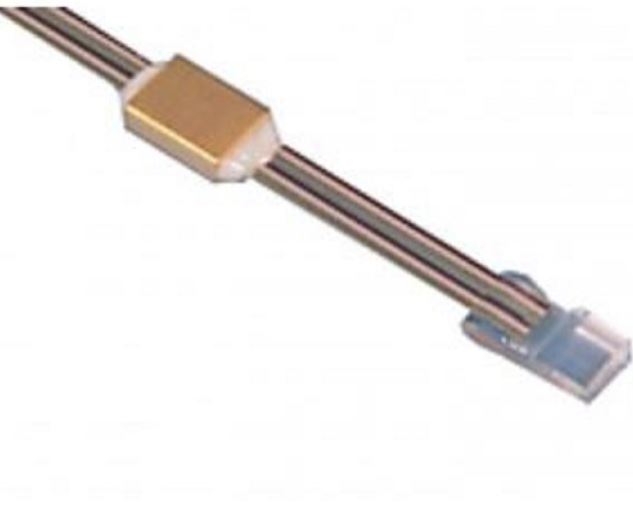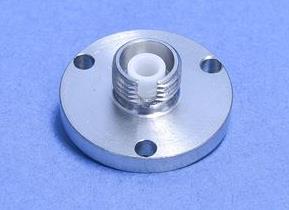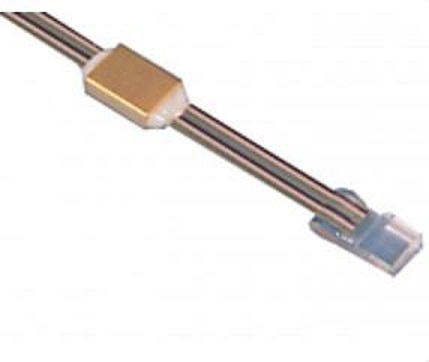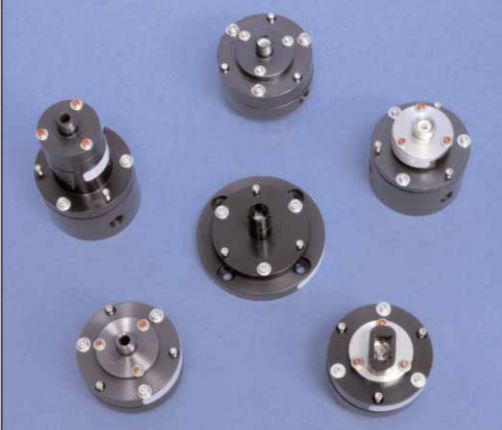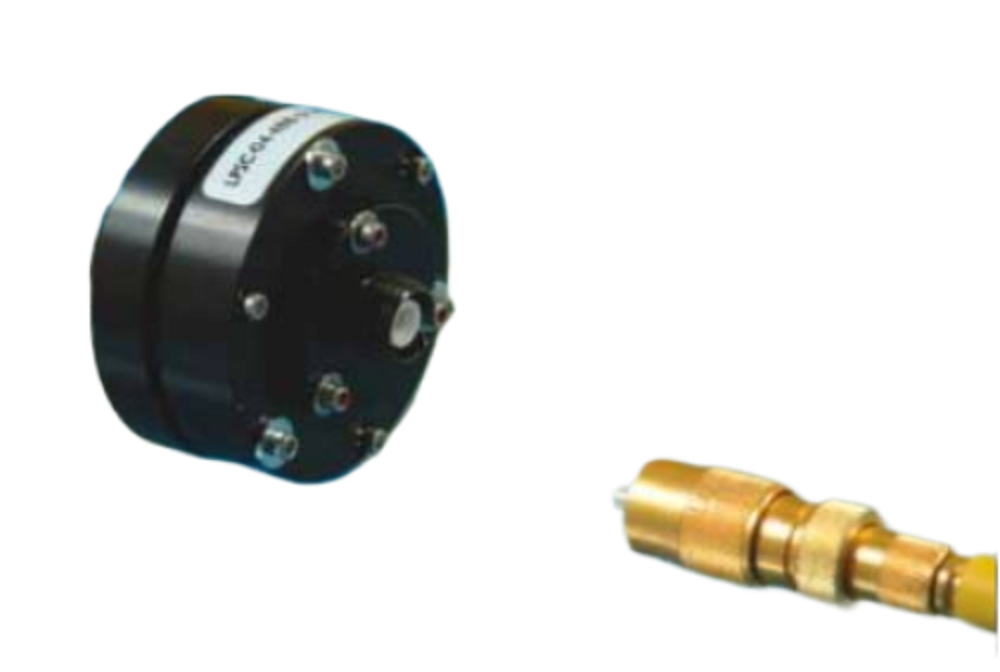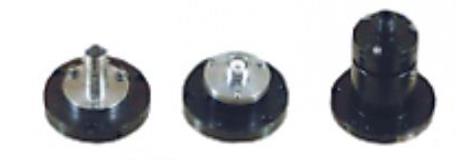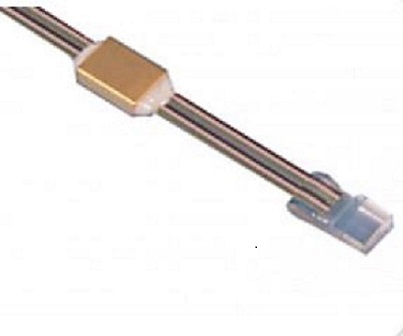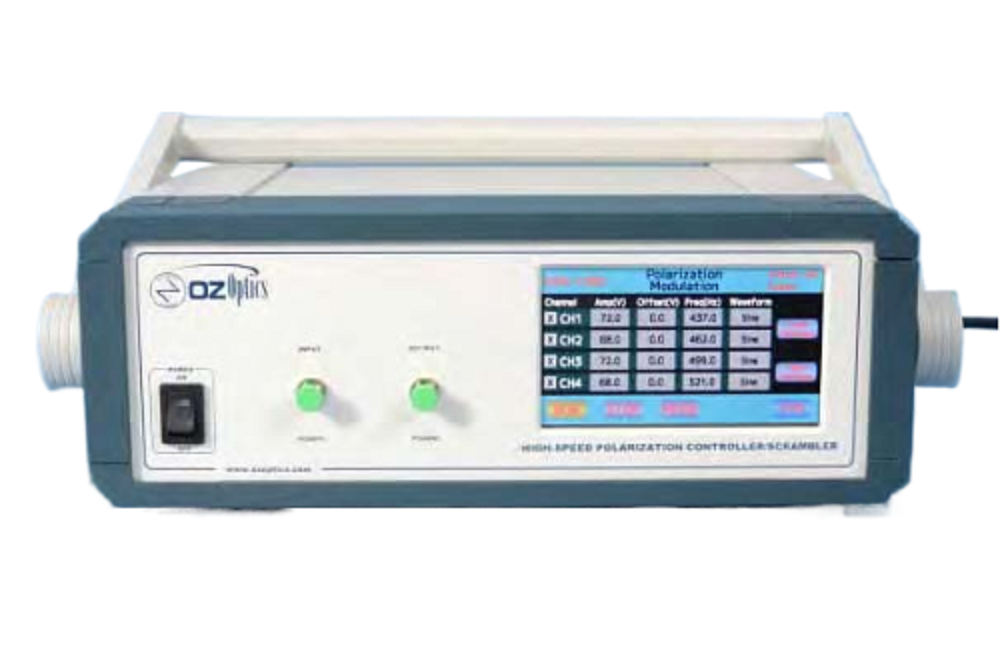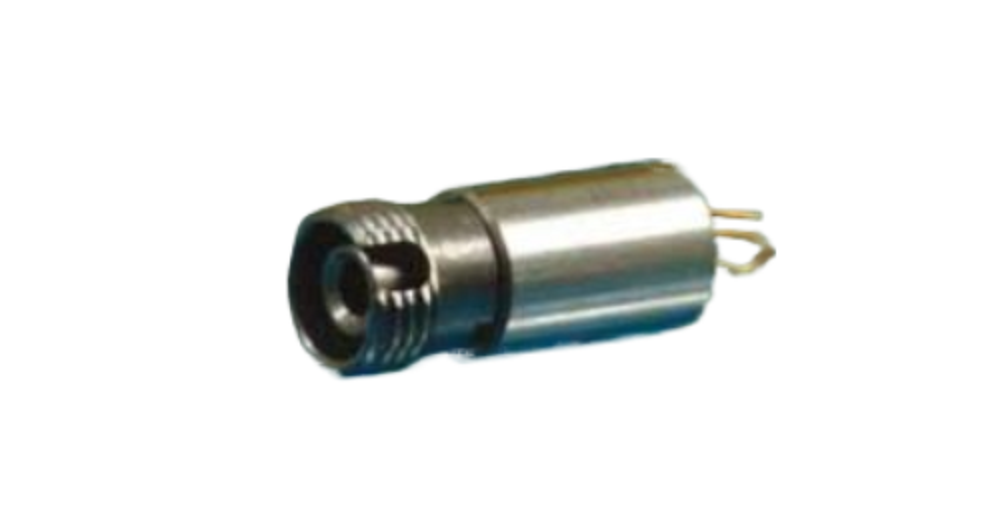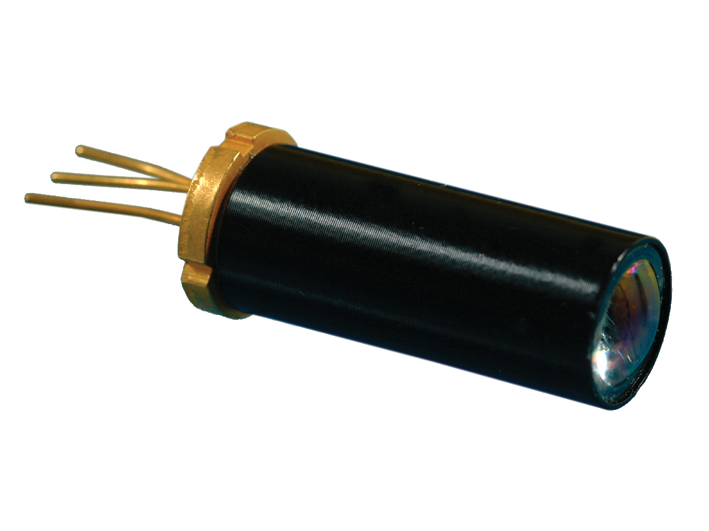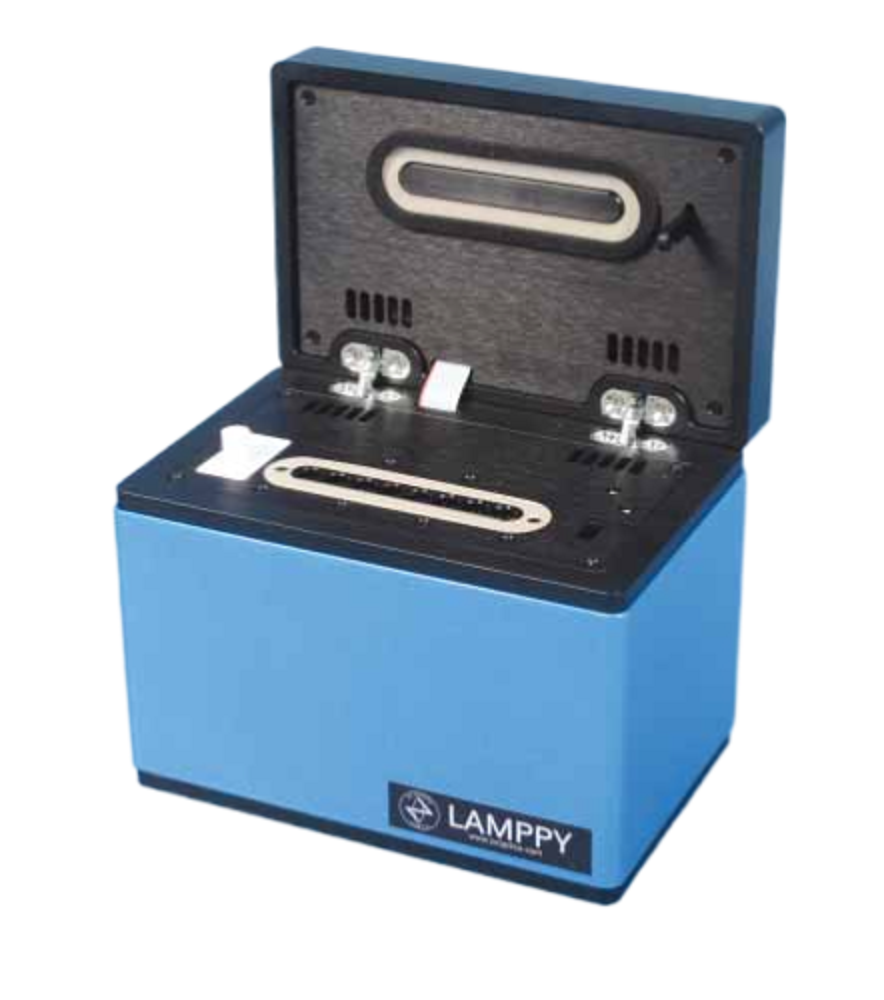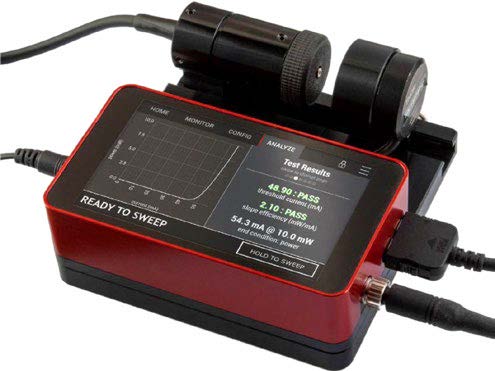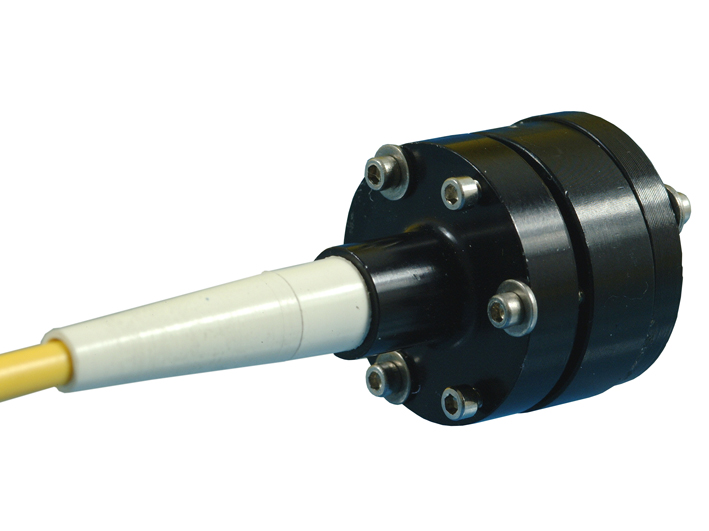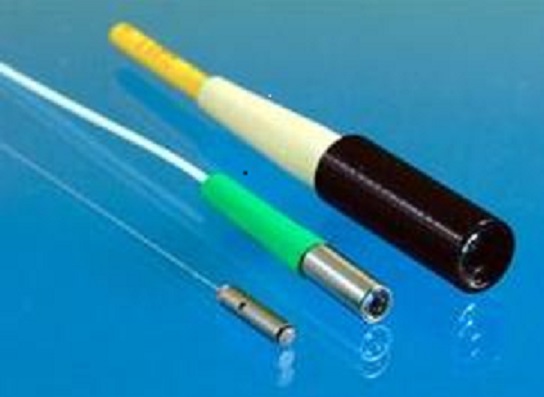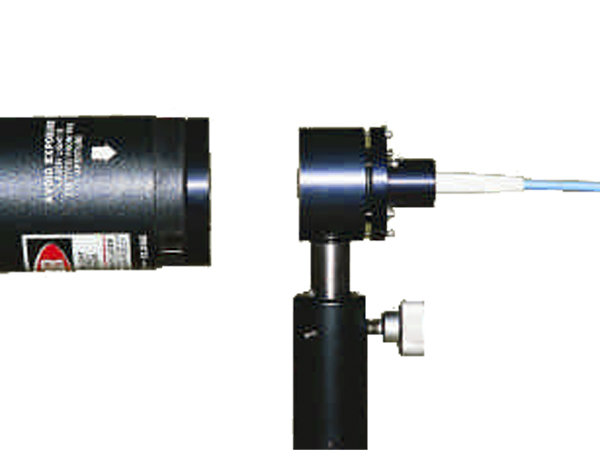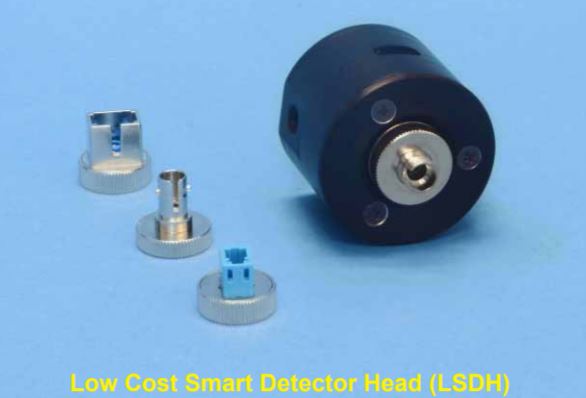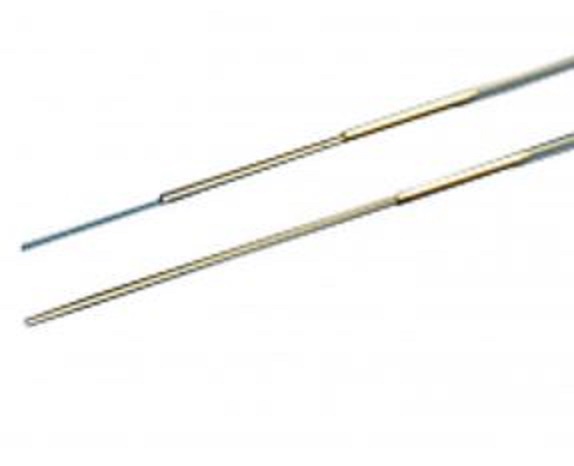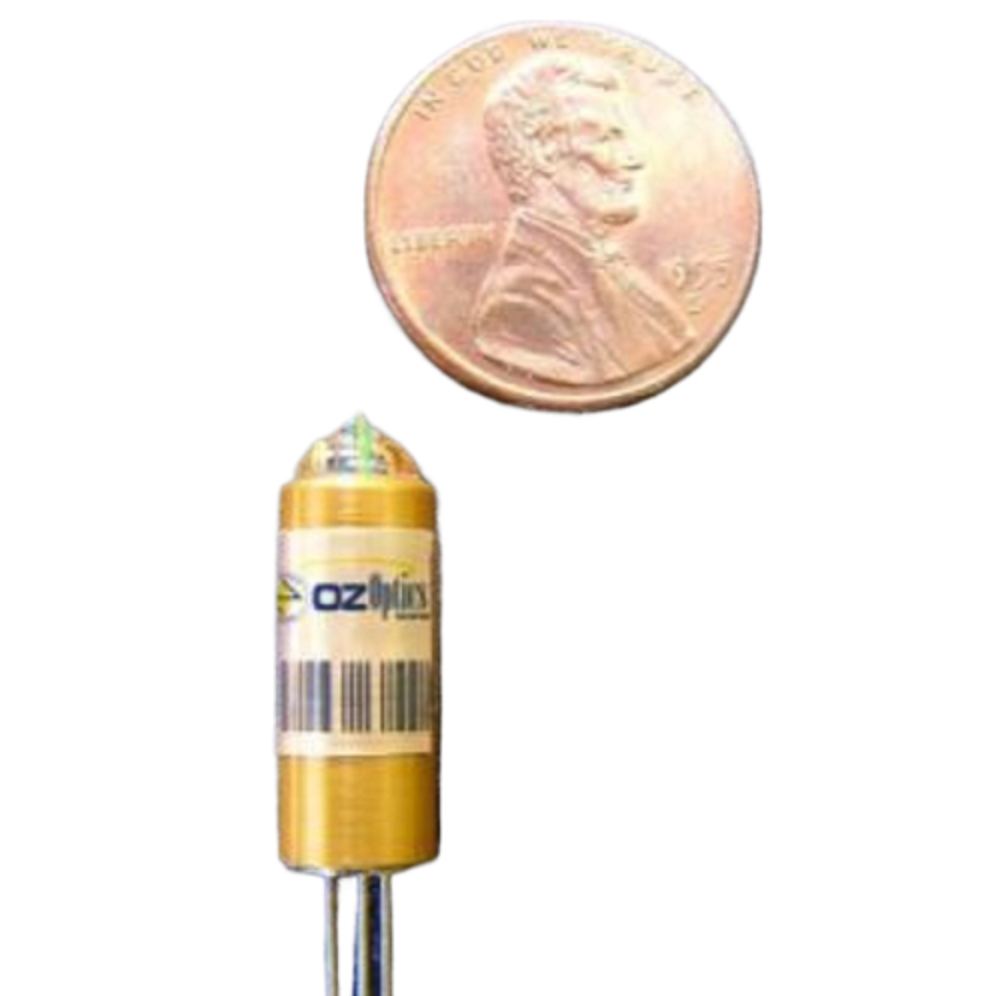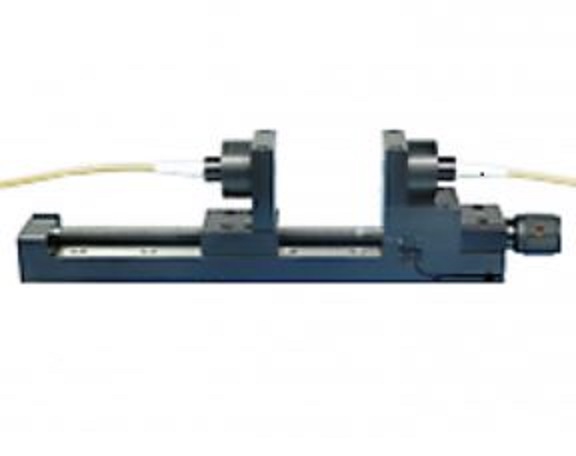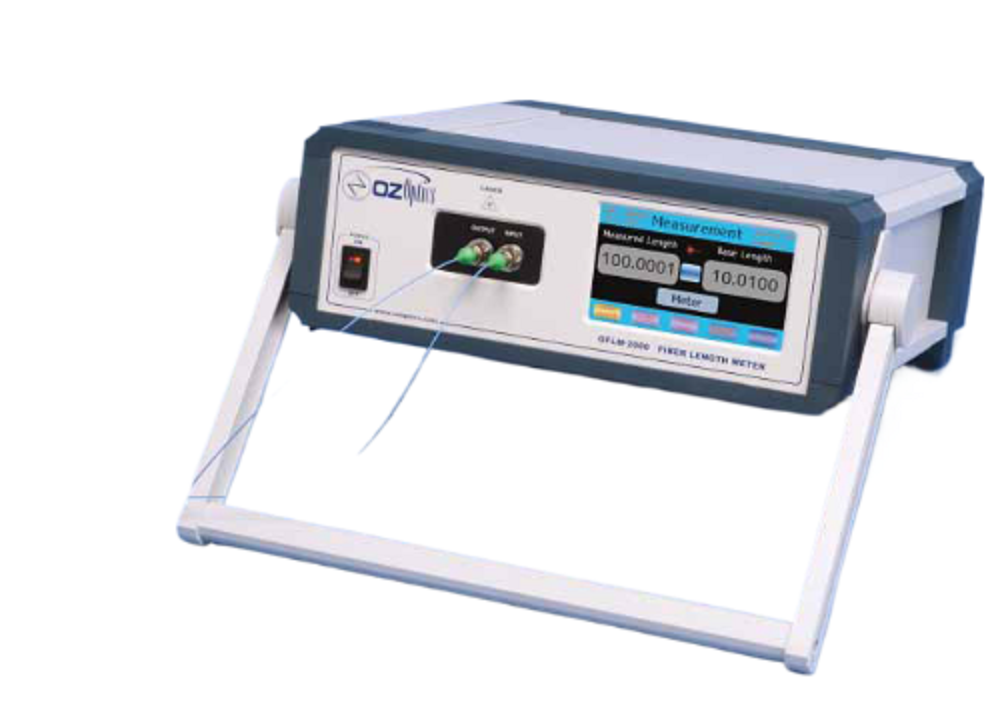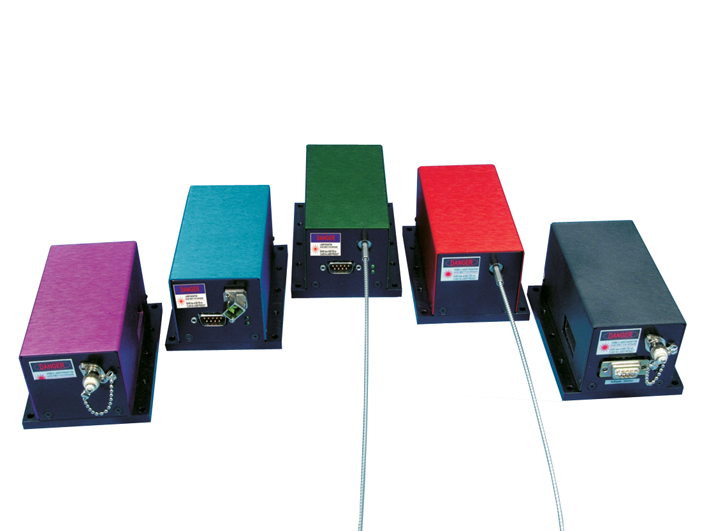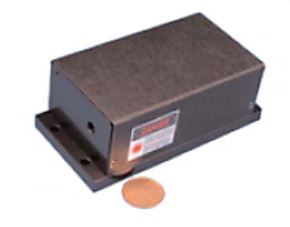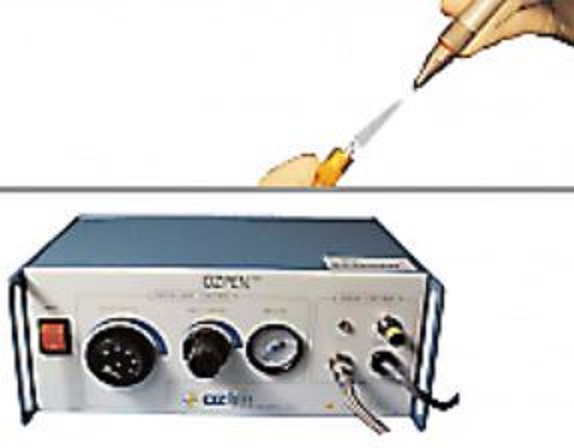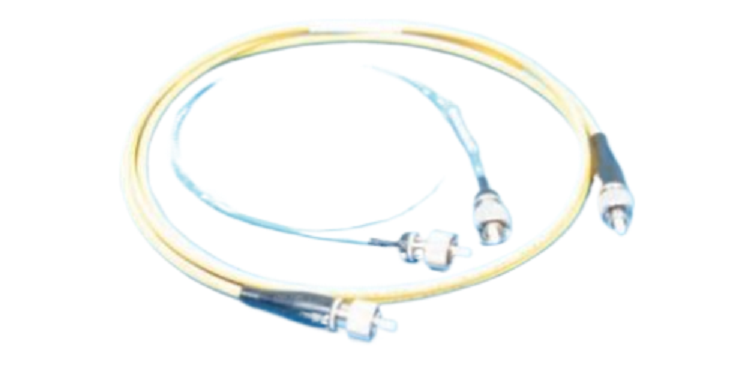Filter
–
OZ Optics
HMMJ Hermetically Sealable MM Patch Cables
Multi Mode Patchcords, Metal Solder; Polarization Extinction Ratio >20, >25, >30 dB; Helium Leak Rate<10-8 ATM-cc/s; Operating Temperature -40 to +85 °C; Max. Installation Temperature +210 °C
OZ Optics’ HMMJ series of hermetically sealable multi mode patchcords with metal solder are designed for today's stringent requirements for component packaging. Utilizing metalized fiber and a proprietary sealing process, these patchcords feature a rugged hermetic feedthrough that can be soldered into an opto-electronic package using standard tin/lead solders. The hermetic seal tube is gold plated to promote good on-site sealing and corrosion resistance. These assemblies are capable of easily creating a seal that meets industry hermeticity requirements.
Key Features:
High Polarization Extinction Ratios up to 30 dB
Single or Multiple Fiber Designs up to 24 Channels
Ribbon Fiber Versions Available
Can be Installed into Packages with Standard Solders
Gold Plated Seal Tube for Easy Sealability and Corrosion Resistance
Terminated with Round or Rectangular Ferrules
Designed to Meet Telcordia Rrequirements
Custom Configurations Possible
Applications: Laser Diode Packaging; Waveguide Packaging; Integrated Optics Packaging; Vacuum Feedthrough Assemblies
Product number:
SW10610
Manufacturer:
OZ Optics
HPLC-NTT/FC-SM FC Bulkhead Receptacle
€30.00*
FC/PC - Type N (Wide Key); Round; Zirconia Sleeve; Simplex; SM/PM
Bulkhead receptacles allow one to attach fiber patchcords to an opening, to project light into free space where it can be used by other optical devices, such as lenses and detectors. These receptacles feature precision zirconia sleeves to center the fiber as well as a stop to ensure the fiber tip stops at a precise point in space.
Product number:
C002775-6
Manufacturer:
OZ Optics
HPMJ Hermetically Sealable PM Patch Cables
Polarization Maintaining Patchcords. Metal Solder; Polarization Extinction Ratio >20, >25, >30 dB; Helium Leak Rate<10-8 ATM-cc/s; Operating Temperature -40 to +85 °C; Max. Installation Temperature +210 °C
OZ Optics’ HPMJ series of hermetically sealable polarization maintaining (PM) patchcords with metal solder are designed for today's stringent requirements for component packaging. Utilizing metalized fiber and a proprietary sealing process, these patchcords feature a rugged hermetic feedthrough that can be soldered into an opto-electronic package using standard tin/lead solders. The hermetic seal tube is gold plated to promote good on-site sealing and corrosion resistance. These assemblies are capable of easily creating a seal that meets industry hermeticity requirements.
PM fibers offer a means to control polarization of optical signals throughout the system, thus controlling Polarization Dependant Losses (PDL) and Polarization Mode Dispersion (PMD). This control is crucial in developing high speed, 40 Gbs, 100 Gbs coherent detection systems. In general, OZ Optics uses polarization maintaining fibers based on the PANDA fiber structure when building polarization maintaining components and patchcords. However OZ Optics can construct devices using other PM fiber structures. If necessary, OZ Optics is willing to use customer supplied fibers to build devices.
Key Features:
High Polarization Extinction Ratios up to 30 dB
Single or Multiple Fiber Designs up to 24 Channels
Ribbon Fiber Versions Available
Can be Installed into Packages with Standard Solders
Gold Plated Seal Tube for Easy Sealability and Corrosion Resistance
Terminated with Round or Rectangular Ferrules
Designed to Meet Telcordia Rrequirements
Custom Configurations Possible
Applications: Laser Diode Packaging; Waveguide Packaging; Integrated Optics Packaging; Vacuum Feedthrough Assemblies
Product number:
SW10611
Manufacturer:
OZ Optics
HPUC Laser to Fiber Couplers
Receptacle Style; 180 to 2000 nm; Coupling Efficiency >60% to >80%; Backreflection -14 to -60 dB; Power Handling >1 to >100 W
In OZ Optics' HPUC series of receptacle style, non-contact style laser to fiber couplers, an air gap exists between the fiber and the lens. This design is more flexible, allowing a wide range of lens types and focal lengths to be used. The distance between the fiber and the lens can be adjusted to compensate the changes in the source wavelengths or to intentionally defocus the laser beam to prevent arcing in high power laser to multimode fiber applications. Couplers using GRIN lenses, achromats, aspheres, fused silica, plano-convex, and biconvex lenses have all been made utilizing this design.
Non-contact style couplers can handle input powers of up to 100 W CW, and even higher energies from pulsed sources. They are best suited for applications where either the input energy is higher than 400 mW, or when more than one wavelength is to be coupled into the fiber, or for input beams that have unusually large beam diameters or divergence angles. They also have superior polarization maintaining capabilities compared to physical contact style couplers. However because of the air gap between the fiber and the lens, the backreflection level for the endface of the fiber is about -14 dB. This can be reduced to -40 dB to -60 dB by slant polishing both fiber ends to deflect the backreflected signal.
There is a significant variation in the endface geometries of angled PC (APC) connectors. This effects the spacing between the endface of the fiber and the lens. To minimize this variation, OZ Optics offers an angled flat (AFC) connector. This connector features a beveled endface where the fiber itself is angled but the ferrule tip is flat. This geometry provides optimum repeatability between connections.
For users of SMA connectors, please note that standard SMA connectors and receptacles are constructed to rather loose tolerances, leading to poor repeatability. For core diameters of 100 µm or smaller, we recommend using SMA connectors with Zirconia ferrules and receptacles with Zirconia sleeves. This will give maximum repeatability. Better still, consider using FC connectors instead.
Key Features:
High Power Handling
Wide Range of Lenses
Excellent Polarization Maintaining Capabilities
Different Connector Receptacle Versions
Wide Wavelength Ranges
Applications: Laser Shows/Entertainment; Spectroscopy; Interferometric Sensors; Fluorescence Measurements; Medical, Pharmaceutical & Chemical Sensors; OEM Laser Systems
Product number:
SW10524
Manufacturer:
OZ Optics
HPUC-2A Laser to Fiber Couplers
Adjustable Focus; 200 to 2100 nm; Power >5 to >100 W CW; Coupling Efficiency >70% to >90%; Fiber Type SM, MM or PM
HPUC-2A adjustable focus source couplers are ideal for situations where optical coupling efficiency is critical, such as in high power applications. A special connector allows the spacing between the fiber and lens to be precisely controlled without rotating the fiber. This is ideal in polarization maintaining applications, as the polarization axis does not change. The adjustments allow to compensate for any change in wavelength or beam wave location, thus further optimizing the coupling efficiency. The optimized coupling efficiency leads to minimized heating of the fiber, especially important with high power.
Adjustable focus couplers are available with a variety of lens types and fiber types. Internal surfaces are angle polished and/or AR coated to minimize backreflection. Typical backreflection levels are -40dB, with -60dB available for certain options. In our OZ Optics portfolio you also find fiber patchcords with adjustable FC/PC connectors only. For more information please see the patchcord section or contact us for further assistance.
Key Features:
Can handle power up to 100 W CW
Patented connector designs for precise coupling with focus adjustment
Excellent coupling efficiency up to 90%
Operating wavelengths 200 nm to 2100 nm
Fiber end caps with ±25 µm thickness tolerance
Applications: Laser Marking, Cutting & Welding; Laser Shows & Entertainment; Materials Processing; High-power Spectroscopy; Non-linear Optics; Laser Surgery; LIDAR; Interferometric Sensors; Laboratory; Education & Training; Visual Laser Alignment for Manufacturing; Medical, Pharmaceutical & Chemical Sensors; Fluorescence Measurements; OEM Laser Systems
Product number:
SW10523
Manufacturer:
OZ Optics
HPUCO, HPUFO Receptacle Style Collimators & Focusers
Wavelength 200 nm to 2100 nm; Focal Length 1.13 mm to 50 mm; Singlemode, Multimode & PM Fibers; Connector Options NTT-FC/PC; AT&T-ST, SC, LC/PC
OZ Optics offers a complete line of fiber collimators and focusers with low backreflection, designed to collimate or focus light exiting a fiber to a desired beam diameter or spot size. These devices can be used with laser diodes, photodiodes, acousto-optic modulators and other fiber optic devices.
Product number:
SW10278
Manufacturer:
OZ Optics
HSMJ Hermetically Sealable SM Patch Cables
Single Mode Patchcords, Metal Solder; Polarization Extinction Ratio >20, >25, >30 dB; Helium Leak Rate<10-8 ATM-cc/s; Operating Temperature -40 to +85 °C; Max. Installation Temperature +210 °C
OZ Optics’ HSMJ series of hermetically sealable single mode patchcords with metal solder are designed for today's stringent requirements for component packaging. Utilizing metalized fiber and a proprietary sealing process, these patchcords feature a rugged hermetic feedthrough that can be soldered into an opto-electronic package using standard tin/lead solders. The hermetic seal tube is gold plated to promote good on-site sealing and corrosion resistance. These assemblies are capable of easily creating a seal that meets industry hermeticity requirements.
Key Features:
High Polarization Extinction Ratios up to 30 dB
Single or Multiple Fiber Designs up to 24 Channels
Ribbon Fiber Versions Available
Can be Installed into Packages with Standard Solders
Gold Plated Seal Tube for Easy Sealability and Corrosion Resistance
Terminated with Round or Rectangular Ferrules
Designed to Meet Telcordia Rrequirements
Custom Configurations Possible
Applications: Laser Diode Packaging; Waveguide Packaging; Integrated Optics Packaging; Vacuum Feedthrough Assemblies
Product number:
SW10609
Manufacturer:
OZ Optics
HSPC-1000 High-Speed Benchtop Polarization Controller/Scrambler
Benchtop Type; 1260-1650 nm; 4 Channels; Min. Retardation Range 2π; Fiber Type SM (9/125 µm); Connector Type FC/PC, FC/APC, SC/PC, SC/APC, LC/PC
OZ Optics’ HSPC-1000 high-speed benchtop polarization controller/scrambler can control and/or scramble the polarization state of light passing through a fiber optic system. The HSPC-1000 generates four independent waveforms, operating at user-selectable frequencies, to generate different polarization states. It can also provide user-adjustable steady state signals to generate a particular polarization state.
The HSPC-1000 contains four optical retardation elements that are used to produce any state of polarization. Each of these elements is controlled by an electrical signal, generated by an internal piezoelectric element in the device driver. The driver produces the appropriate drive signals: four independent signals that can be directly controlled by the HSPC-1000 high-speed benchtop polarization controller/scrambler.
Key Features:
Wavelength Range: 1260 nm to 1650 nm (Standard, Other Wavelengths Available on Request)
Electric Polarization Controller and Driver Combined into One Unit
Fixed or Random State Generation
User-selectable Frequencies up to 1 kHz
User Control of Polarization State
Rugged Casing
Quick Setup
LCD Touch Screen Operation
Connector Types: FC/PC, FC/APC, SC/PC, SC/APC, LC/PC
Number of Channels: 4
Retardation Range: 2π Minimum
Insertion Loss (IL): 0.05 dB (Not Including Connectors)
Backreflection: >60 dB (Not Including Connectors)
Activation Loss: ±0.05 dB
Polarization Dependent Loss (PDL): <0.06 dB
Fiber Type: Single Mode (SM) Fiber, 9/125 µm
Modes of Operation: Constant Voltage (DC); Sine or Triangle Waves (User-Selectable Frequency & Amplitude)
Frequency Range (Sine Wave Output): 0 to 1 kHz @140 V
Frequency Resolution: 0.1 Hz
Output Voltage Range: 0 V to 140 V
Voltage Resolution (AC & DC Modes): 0.633 mV
Power Supply: 120/240 VAC, 4 A , 50/60 Hz
Operating Temperature Range: -20°C to +35°C at 140 V and 2 kHz, -20°C to +45°C at 140 V and 1 kHz
Dimensions: 110 x 280 x 300 mm, Not Including Handle
Weight: 5.5 kg
Applications: Polarization Scrambling; Measuring Polarization Dependent Loss (PDL); Manufacturing and Quality Control; Studying Effects of Polarization; Controlling Polarization State
Product number:
SW11773
Manufacturer:
OZ Optics
HULD Laser Diode to Fiber Couplers
Receptacle Style; 375 to 2000 nm; Wavelength Accuracy ±5 to ±30 nm; Coupling Efficiency 10% to 75%; Fiber Type SM, MM or PM
OZ Optics’ HULD series of receptacle style laser diode to fiber couplers is offering optimum coupling in a small, rugged package. The couplers may be purchased prealigned, with the diode already in place, or as a kit that can be assembled by the customer using their own diode. The complete assembly procedure is quite straightforward. An assembly and operating instruction video on a USB drive, showing the alignment process, is available. In addition, a complete alignment kit is available, which includes the laser diode collimation wrench, multimode fiber assembly, centering lens, and video instructions.
Diode source couplers are available for a variety of diode case sizes, and for diode wavelengths from 375 nm to greater than 2000 nm. These source couplers work with MM, SM and PM fiber. HULD connector receptacle style couplers have a female receptacle, such as NTT-FC, or AT&T-ST, etc. at the output end. This allows the user to connect any optical fiber with a matching male connector to the diode. HULD laser diode to fiber couplers are available in different diameters from 0.79 inch to 1.3 inch. These tilt adjustable source couplers can be used over a temperature range of -25 °C to +60 °C and have been vibration tested. Higher temperature versions are available on request OZ Optics also offers special, low cost, miniature receptacle style laser diode to fiber couplers for OEM applications. These packages use just a single lens to couple light from the laser diode into the fiber. They do not use OZ Optics tilt adjustment technique. This package features a compact, rugged housing, at a lower cost.
A variety of options like a built-in isolator, a blocking screw to attenuate the output beam as well as polarizers or polarization rotators in the middle are also available.
Key Features:
375nm to 2000nm
Variety of Standard Packaging Options
SM, MM or PM fiber
Rugged Design
Custom Design for Diodes
High-power Version
Applications: Fiber Optic Communications; Optical Alignment Systems; Process Control; Optical Sensors; Medical Apparatus; Imaging Systems ; Test and Measurement Systems
Product number:
SW10522
Manufacturer:
OZ Optics
HULDO Laser Diode Collimators
375 to >2000 nm; 0.59 to 1.3 inch Diameter Flange; Compact Housing; Low Losses; Custom Design for User-specified Diodes Available
OZ Optics' HULDO laser diode collimators are used to collimate the highly divergent beam that is emitted by a laser diode. It consists of a laser diode holder, a collimating lens holder, and a high numerical aperture (NA) collimating lens. By adjusting the distance between the laser diode and the collimating lens, the laser diode output can be collimated. Laser diode collimators are available in different diameters.
The standard diameter package is 0.79 inches in diameter, fitting most diode types. A larger, 1.3 inch diameter housing is used for larger diameter diodes such as H1 or TO-3 packages. For diode can sizes of 9.0 mm or smaller in diameter a 0.59 inch diameter housing is available. Smaller housings with 10 mm OD's are available for OEM applications.We also offer special compact laser diode to fiber couplers for OEM applications. These packages have the diode and collimating lens permanently glued into the same housing. This package features a compact, rugged housing, at a significant reduction in cost.
Choose from our selection of laser diodes, we can also supply you with laser diode power supplies (operating from battery or DC voltage source). We can even provide you with complete miniaturized packaged systems. Contact us for more information on what is available.
Key Features:
Low Losses
High Polarization Extinction Ratios
Compact Housing
Custom Designs for User-specified Diodes
Applications: Optical Alignment Systems; Process Control; Medical Processes; Imaging Systems; Test and Measurement
Product number:
SW10519
Manufacturer:
OZ Optics
LAMPPY Optical DNA Rapid Detection System For Pathogens
High-intensity LED Array; 478 nm; Detection Range 500-595 nm; Optical Dynamic Range 60 dB; Electrical Dynamic Range 120 dB; Acquisition Frequency 10 s-2 min
With LAMPPY™, OZ Optics provides an exceptionally affordable, yet reliable optical DNA detection system based on isothermal techniques such as "Loop-mediated Isothermal Amplification" (LAMP). Much like "Polymerase Chain Reaction" (PCR) amplification, LAMP is a highly sensitive method of DNA detection that creates billions of copies of a target DNA from a minute amount of sample RNA or DNA. However, unlike PCR, LAMP applies an isothermal process that does not require expensive and complex equipment, nor time consuming thermal cycling. It is a more cost-effective and rapid system.
LAMP is especially ideal for rapid diagnosis of pathogens or infectious diseases, with results usually within 30 minutes and for high viral loads less than 20 minutes. The LAMPPY™ system uses an array of high powered LEDs, photodiodes and filters for real-time quantitative detection. The system can be paired with an external battery for a compact, field-deployable diagnostic instrument.
Samples to be tested are first mixed with a solution of primers, enzymes, an intercalating dye, and several other components. This mixture is then dispensed into standard 0.1 mL PCR tubes with flat caps, commonly known as low-profile PCR tubes. Acceptable sample volumes can be between 5 µl and 125 μl (10 to 30 μl recommended).
The instrument can work with many different solution kits from third parties for different pathogens. For that reason, OZ Optics considers it to be a universal DNA/RNA detection system. The standard system utilizes an excitation diode/filter combination emitting at 450 nm to 488 nm and a filter/detector combination for 500 nm to 595 nm light. This setup is compatible with many popular fluorescent dyes, including SYTO 9, SYBR Green and EvaGreen dyes. Solution kits using these or similar dyes can work with the instrument as-is. However, if the user wants to work with different dyes that utilize different wavelengths, AMS Technologies can provide filter blocks with different filter combinations. The filter blocks can be exchanged by the user, making the instrument extremely versatile and easy to service with downtime reduced to a minimum.
The accompanying software is intuitive and easy to use, providing quantitative measurements in real-time while allowing fast and easy setup of assays, protocols, and experiments that can be saved and reused. It will automatically detect attached instruments for quick setup and can run multiple instruments simultaneously on one computer. Data can be exported as CSV, XML, JSON, or PNG. Standard communication is via a USB cable, wireless communication via Wi-Fi will also be offered.
Key Features:
Use to Detect Viral, Fungal, and Bacterial DNA/RNA Including Covid-19, SARS, Ebola, Cholera, Salmonella, etc.
Rapid DNA/RNA Detection (from 20 min)
Highly Sensitive and Specific Detection of Low Viral Levels
Intuitive Software Displays Real-time Data During Testing
Melt Analysis Available With the Included Software
Lid Heater Prevents Evaporation and Condensation
Compact Modular Design Allows for Easy Cleaning and Maintenance
Pair With an External Battery for a Portable and Field-deployable System
Test up to 8 Samples Simultaneously (Higher Throughput Systems With up to 96 Samples Available Upon Request)
Wireless Communication to Computers and Smartphones (coming soon)
A Fraction of the Cost of qPCR-based Systems
Private Labelling for Volume OEM Applications on Request
Electrical Dynamic Range: ~120 dB
Optical Dynamic Range: ~60 dB
Excitation Wavelength: 478 nm, FWHM = 20 nm (Typical)
Detection Wavelength Range: 500 nm to 595 nm
Temperature Range: Adjustable From Ambient to +94°C (Block) and +99°C (Lid) in 1°C Increments
Heating Ramp Rate: ~9.6 s/°C
Standard Throughput / Test Wells: 8
Acquisition Frequency: 10 s to 2 min
Light Source: High-intensity LED Array
Detector: Photodiode Array
Interface: USB Type B
Power Supply: 100-240 VAC Input, 12 VDC Output, <50 W
Dimensions: 163 x 104 x 127 mm
Weight: 1.67 kg
Applications: Screening and Diagnosis of Infection Disease; Food and Water Testing for Microbes; Molecular Biology Research; Dry Block Incubator
Product number:
SW11790
Manufacturer:
OZ Optics
LDA-100 Laser Diode Analyzer
Laser Diode Current 0-500 mA; LD Compliance Voltage 0.0-8.0 V; TEC Current 0-1 A; TEC Voltage Range ±8.00 V; Photodiode Current 0-3600 μA; Setpoint Resolution 0.1 mA; Setpoint Accuracy ±0.05%
OZ Optics’ LDA-100 low cost, compact and standalone laser diode analyzer provides quick and versatile laser diode characterization and parametric analysis. The unit features a high-resolution LIV (light, current, voltage) measurement system, providing all main laser diode parameters including threshold current and slope efficiency. The setup and measurement takes only a few seconds.
The measured parameters are displayed on a color touch screen, and the data can be downloaded to any host computer for further processing and analysis through a built-in USB interface. The unit features a built-in smart driver that will automatically detect the laser diode pinout. The user can select to operate the laser diode under test in either auto-current or auto-power control modes. The integrated TEC controller maintains your diode at its operating temperature, ensuring accurate and repeatable measurements.
The smart laser diode analyzer comes with multiple features for safe and accurate measurements. These features include current limit protection, automatic pinout detection, sensor range checks and manager passcode level to prevent any accidental changes of the preset settings that could otherwise harm the laser diode under test, or invalidate the results. External interlocks can be connected to disable the laser diode in response to safety concern situations.
Each unit is provided as a set that includes all required accessories for direct plug-and-play operation. The kit includes a calibrated optical power meter head and a thermally controlled laser diode holder for 5.6 mm package laser diodes (holders for 3.8 mm and 9 mm packages are offered separately). A simple sliding mechanism allows easy laser diode replacement. Special laser diode adapters can be customized upon request for any laser diode package.
Key Features:
Integrated Temperature Controller
Compact Plug-and-Play Laser Diode Analyzer
Fast and Accurate LIV (Light, Current, Voltage) Curve Generation With 0.1 mA Resolution
Setpoint Resolution: 0.1 mA
Setpoint Accuracy: ±0.05%
Laser Diode Compliance Voltage: 0.0 V to 8.0 V
Laser Diode Drive Current up to 500 mA
Photodiode Current Range: 0 μA to 3600 μA
Photodiode Current Resolution: 0.1 μA
15-bit Power Resolution
3 W Output TEC Temperature Controller
Max. TEC Current: 1 A
TEC Voltage Range: ±8.00 V
Temperature Control Range: +10°C to +50°C
Password Protection, Hardware Interlock and Overcurrent Shut-off Circuitry for Safety
Built-in Smart Driver for Diode Pinout Auto Detection and Temperature Control
Touchscreen Control and Accompanying Windows Software
Operating Rel. Humidity: <85%, Non-condensing
Dimensions Analyzer: 110 x 63 x 30 mm
Dimensions Analyzer + Accessories: 110 x 115 x 45 mm
Weight Analyzer: 300 g
Weight Analyzer + Accessories: 1000 g
Applications: Laser Diode Characterization; Laser Diode Quality Control; Laser Source Calibration
Product number:
SW11748
Manufacturer:
OZ Optics
LDPC Laser Diode to Fiber Couplers
Pigtail Style; 375 to 2050 nm; Laser Diode Power 5 to 150 mW; Coupling Efficiency 25% to 55%; Fiber Type SM, MM or PM
OZ Optics’ LDPC series of pigtail style laser diode to fiber couplers is offering optimum coupling in a small, rugged package. The couplers may be purchased prealigned, with the diode already in place, or as a kit that can be assembled by the customer using their own diode. The complete assembly procedure is quite straightforward and can be done in less than twenty minutes. A complete alignment kit, which includes tools and video instructions, is available separately.
Laser diode source couplers are available for a variety of diode case sizes, and for diode wavelengths from 375 nm to greater than 2050 nm. These source couplers work with MM, SM and PM fiber. Pigtail style laser diode to fiber couplers provide higher coupling efficiencies and lower backreflection levels than receptacle style couplers, as well as better stability. The output fiber can be terminated with different output connectors, as desired.
Laser diode to fiber couplers are available in different diameters from 0.5 inch to 1.3 inch. These tilt adjustable source couplers can be used over a temperature range of -25 °C to +60 °C and have been vibration tested. Higher temperature versions are available on request.OZ Optics also offers special, low cost, miniature pigtail style laser diode to fiber couplers for OEM applications. These packages use just a single lens to couple light from the laser diode into the fiber. They do not use OZ Optics tilt adjustment technique. This package features a compact, rugged housing, at a significantly lower cost. A variety of options like a built-in isolator, a blocking screw to attenuate the output beam as well as polarizers or polarization rotators in the middle are also available.
Key Features:
375nm to 2050nm
Variety of Standard Packaging Options
SM, MM or PM fibe
Rugged Design
Applications: Fiber Optic Communications; Optical Alignment Systems; Process Control; Optical Sensors; Medical Apparatus; Imaging Systems ; Test and Measurement Systems; OCT Systems
Product number:
SW10521
Manufacturer:
OZ Optics
LPC, LPF Pigtail Style Collimators & Focusers
Wavelength 180 nm to 2000 nm; Focal Length 1.05 mm to 18.68 mm; Singlemode, Multimode & PM Fibers; Connector Options NTT-FC/PC; AT&T-ST, SC, LC/PC
OZ Optics offers a complete line of fiber collimators and focusers with low backreflection, designed to collimate or focus light exiting a fiber to a desired beam diameter or spot size. These devices can be used with laser diodes, photodiodes, acousto-optic modulators and other fiber optic devices.
Product number:
SW10277
Manufacturer:
OZ Optics
LPSC Laser to Fiber Couplers
Pigtail Style; 200 to 2100 nm; Coupling Efficiency >60% to >80%; Backreflection -35 to -60 dB; Power Handling >1 to > 100 W
OZ Optics' LPSC pigtail style laser to fiber couplers are recommended for permanent or semi-permanent situations, where optimum coupling efficiency, output stability, and minimum backreflection are desired. In these couplers the fibers are permanently glued to the focusing lens. The fiber-lens assembly is then inserted into the tilt adjustment flange and held in place with two radial set screws. Because the fiber is permanently attached to the lens, the fiber cannot be replaced without also replacing the coupling lens.
In pigtail style couplers the internal endface of the fiber is polished at an angle to reduce backreflection. This ensures <-40 dB backreflection. By adding an anti-reflection coating to the inner fiber tip, backreflection can be further improved to -60dB.
Key Features:
Wavelength Range 200 nm to 2100 nm
Coupling Efficiency up to 90%
Polarization Maintaining Capabilities up to 35 dB
Rugged, Compact, Stable Design
Low Backreflection
Environmentally Stable
Adjustable Output Power
Applications: Interferometric Sensors; Medical, Pharmaceutical & Chemical Sensors; Fluorescence Measurements; Spectroscopy; Laser Shows/Entertainment; OEM Laser Systems
Product number:
SW10525
Manufacturer:
OZ Optics
LSDH/POM-600 OEM Fiber Power Meters
OEM Type Optical Power Meters, No Display; 450 to 1650 nm; Power Measurement -65 to +10 dBm; Accuracy ±5%; Resolution 0.01 dB; FC, SC, ST, LC Receptacles
OZ Optics’ LSDH/POM-600 series of smart detector heads/optical power monitors offers OEM modules (with no built-in display) that can be embedded in systems for remote power monitoring or for long term power logging for burn-in test stations. These OEM versions come with a USB interface in the LSDH (round base) and with RS232 in the POM-600 (rectangular base).
SPI or I2C remote interfaces can be provided on demand for volume OEM orders. Customers can install OZ Optics’ provided user graphical interface on a host PC to display the measured optical power. Or customers can use the device commands to develop their own user graphical interface.
The LSDH/POM-600 series of smart detector heads/optical power monitors offers a high, greater than 60 dB linear dynamic range and can be easily embedded in long-term power monitoring stations like environmental optical test systems or long term burn-in stations. The device can be offered with calibration at discrete wavelengths or with no wavelength calibration for relative power measurements. Customers may also perform their own calibration.
OZ Optics also offers equivalent pocket size units with built-in displays. For further information please refer to the POM-500 series of pocket fiber power meters and the POM-400 series of miniature fiber power meters.
For handheld units with built-in displays and a choice of additional receptacles, please refer to OZ Optics’ POM-300 series of handheld fiber power meters.
Key Features:
Slim and Compact
Built-in InGaAs Detector for IR Range or Si Detector for Visible
Interchangeable Optical Connectors Available
Calibrated and Uncalibrated Versions Available
Customers May Perform Their Own Calibration
USB and RS232 Interfaces
Applications: Long-term Remote Power Monitoring; Fiber Optic Assembling and Testing; Optical Test Systems; Passive Optical Components Burn-in Stations; General Optical Power Measurements; Embedded Systems
Product number:
SW10883
Manufacturer:
OZ Optics
ME Metalized Fibers
Gold Coated, Other Materials on Request; Fiber Type SM, MM, PM; Metalization Thickness 1.65 to 5.2 µm; Maximum Plating Length 50 mm; Operating Temperature -40 to +85 °C
OZ Optics’ ME series of metalized fibers are specifically designed for optoelectronic packaging. The fiber is first coated with a layer of nickel to provide superior adhesion and a stable soldering base. The fiber is then plated with an overcoat layer of gold to provide resistance to oxidization. The result is a strong, uniform coating capable of handling the rigors of soldering and hermetic sealing. OZ Optics metalized fibers are well suited for use in assemblies that must conform to Telcordia requirements. If required, OZ Optics metalized fibers can be manufactured with masked ends. This process provides a clean, non-metalized fiber end suitable for termination with ceramic ferrules, fusion splicing or direct connection to a device and allows for an easy transformation of devices into hermetically sealed packages. Also available are custom mid-span metalization of optical fibers and metalized ribbon fibers. The mid-span configuration provides a solution for hermetically sealing in-fiber devices such as fiber Bragg gratings, optical isolators or optical filters, as well as allowing larger package devices that exceed the length restrictions of standard metalized fibers. Metalization of ribbon fibers allows for easy hermetic sealing of multiple fibers into hermetic packages that require many fibers or are being used with V-Groove assemblies. OZ Optics metalized fibers are available with Single Mode (SM), Multi Mode (MM) or Polarization Maintaining (PM) fibers. In general, OZ Optics uses polarization maintaining fibers based on the PANDA fiber structure when building polarization maintaining components and patch cords. However, OZ Optics can construct devices using other PM fiber structures. OZ Optics also carries some alternative fiber types in stock, please contact AMS Technologies for availability. If necessary, OZ Optics is willing to use customer supplied fibers to build devices. Key Features:
Single Mode (SM), Multi Mode (MM) or Polarization Maintaining (PM) Fibers
Easy to Solder
Cleaved Enfaces Available
Unplated (Masked) Ends Available
Mid-span Plating Available
Designed to Meet Telcordia Requirements
Large Volume Manufacturing Capacity
Custom Configurations Available
Applications: Hermetic Feed-throughs; Integrated Optics Packaging; Diode Pigtailing
Product number:
SW10913
Manufacturer:
OZ Optics
MMVOA Variable Optical Attenuators
MEMS-based; Fiber Type SM, PM; C or L Band; Connector Type (Receptacle) FC/PC, ST, SC; LC, MU, E2000; Attenuation up to 40 dB
OZ Optics’ MMVOA series of MEMS-based variable optical attenuators (VOAs) come in a miniature package. These best-in-class attenuators are available either as single units or as arrays of attenuators in which each VOA has its own independent continuous control. Attenuation is controlled by an analog DC voltage input signal.
OZ Optics’ MMVOA series of MEMS-based VOAs is available with either Single Mode or Polarization Maintaining (PM) fibers. Advanced manufacturing techniques ensure optimum alignment of PM fibers, allowing high Polarization Extinction Ratios while dramatically minimizing assembly costs.
MMVOA series of MEMS VOAs are available in any combination of the following parameters: (1) Single VOAs with 0 to 6.5 V or 0 to 18 V driving power; (2) VOA arrays with 5 V power supply to the module and 0 to 6.5 V on each driving pin; (3) normally open or normally closed.
Architecture: Uni-axial, Uni-directional, MEMS Mirror; Electrostatic Comb; Fully Symmetric
Key Features:
Telcordia GR-1209 and GR-1221 qualified
Small size
Available as Single-channel Discrete VOA, 4 & 8 Channel VOA Arrays and with Higher Port Counts up to 40 VOAs per Module
Normally-open or Normally-closed
Low Voltage (6.5 V) or High Voltage (18 V)
Single Mode or PM Fber
Analog DC Voltage Control
Independent Continuous Attenuation Control for Each Channel
Fast Response, Hight Dynamic Range
Low Insertion Loss, WDL, PDL, TDL
Applications: Signal Power Management in Optical Networks; Dynamic Optical Power Control and Channel Equalization in Add/drop Multiplexers; Power Balancing before Modulation and Multiplexing; Active Gain Equalization in DWDM Systems; Power Control into Receivers; Gain Tilt Control in EDFAs; Channel Balancing for Optimizing Transmission Performance in Long-haul and Metro Networks; Test Equipment
Product number:
SW10542
Manufacturer:
OZ Optics
ODL Fiber Optic Delay Lines
Manual & Motorized Versions; 400 to 2000 nm; Delay Range 13 to 600 ps; Return Loss -35, -40, -50, -60 dB, Fiber Type SM, MM, PM
OZ Optics’ fiber optic delay lines (ODL series) consist of an input and output fiber collimator to project the light into free space and collect it again into a fiber. The distance the light travels in free space is precisely controlled, either by controlling the separation between the input and output optics (ODL-100, ODL-200, ODL-300, ODL-700) or by reflecting the light off a movable reflector (ODL-600, ODL-650). In either case, by varying the distance the light travels, the user can control the delay time through the device. ODL series delay lines are available in both manual and electrically controlled versions. Manual delay lines (ODL-100, ODL-200, ODL-600, ODL-700) utilize either a lead screw or a micrometer to adjust the spacing. Electrically controlled versions (ODL-300, ODL-650) utilize a servo motor with encoders to monitor the motion. With these electronically controlled devices, submicron resolution (<0.003 ps) is achieved. The delay line is easily controlled by a computer via an RS-232 interface or manually using some simple TTL input signals. These devices are calibrated to provide the delay in picoseconds. Home and end position sensors prevent accidental damage to the device. The ODL-700 miniature style delay line provides up to 13 ps delay in a miniature package. The unit takes up little more space than an ordinary patch cord connection and is easily adjustable and lockable. Delay lines are offered using single mode (SM), multi mode (MM) or polarization maintaining (PM) fibers. In general, OZ Optics uses polarization maintaining fibers based on the PANDA fiber structure when building polarization maintaining components and patch cords. However OZ Optics can construct devices using other PM fiber structures. OZ Optics also carries some alternative fiber types in stock, please contact AMS Technologies for availability. If necessary, OZ Optics is willing to use customer supplied fibers to build devices. Key Features:
Low Loss
Sub-picosecond Resolution
Wide Wavelength Range (400 to 2000 nm)
Over 600 ps Delay Range
Polarization Insensitive
Single Mode (SM) and Polarization Maintaining (PM) Fiber Versions
Electrically Controlled Versions Available
Miniature Style Version
Applications: PMD Compensation in High-speed Communications Networks; Interferometric Sensors; Coherent Telecommunications; Spectrum Analyzers; OCT Systems
Product number:
SW10865
Manufacturer:
OZ Optics
OFLM Fiber Length Meters
Single or Dual Port; Fiber Type SM, MM, PM, Specialty; Resolution <2, <4 mm; Maximum Distance 150, 500 m; Connector Type FC, SC, LC; USB Interface
OZ Optics’ OFLM series of optical fiber length meters deliver fast, accurate and reliable measurements of optical fiber lengths. For any application requiring precise and well-controlled optical fiber lengths, this powerful tool saves time and money while preventing measurement errors and improving quality control and performance. With resolution better than 2 mm and repeatability of less than 3 mm, the OFLM series delivers highly accurate optical path length measurements for distances up to 500 m. The system reports and records its measurements to any Windows-based personal computer, allowing easy data logging and report writing. The OFLM series of fiber length meters is an essential tool for constructing and testing fiber optic cables, fiber optic sensors, fiber optic interferometers, and other optical fiber systems where length must be controlled. Take your optical fiber systems to the next level of quality and cost control with the OFLM series today. Key Features:
Measures Lengths From a Few mm up to 500 m
Better Than 2 mm Resolution
Less Than 0.1% Measurement Error
No Dead Zone - Can Measure Fibers Less Than 1 cm Long
Absolute and Relative Measurements
Works With Single Mode (SM), Multi Mode (MM), Polarization Maintaining (PM) and Specialty Fibers
Continuous (1 Hz) Measurements of Optical Fiber Lengths
Saves Time Spent Manually Measuring Fiber Lengths
Improves Quality Control
Portable Benchtop Units
Applications: Optical Fiber Cable Assembly; Production Testing; Optical Network Field Installations; Quality Control and Acceptance Testing; Fiber Optic Sensor Assembly and Testing; Low-cost Dynamic Strain Sensor; Construction of Fiber Interferometers; Fiber Laser Manufacturing; Cable Management
Product number:
SW10907
Manufacturer:
OZ Optics
OZ-1000/2000/3000 Diode Laser Sources
Fiber Coupled, Ultra-stable; 375 to 2000 nm; Wavelength Stability (typ) ±0.2 nm; Output Power 0.5 to 300 mW; Power Stability <0.1% to <2%; Polarization Extinction Ratio >18 to >23 dB; Fiber Type SM, MM or PM
The OZ-1000, OZ-2000 and OZ-3000 fiber pigtailed ultra-stable laser module series are temperature stabilized, fiber coupled, laser delivery systems. The compact housing contains both the laser and the temperature control. Powered by a single 5 V DC supply, the low noise laser diode and TEC drivers maintain the wavelength variation to better than 0.2 nm, and also reduce the tendency of the laser diode to mode hop, assuming there is no feedback into the laser cavity.
The electrical interface on the OZ-1000 is located on the front face of the unit alongside the optical interface, while on the OZ-2000 and OZ-3000 it is on the rear of the unit. The three configurations have as default analog CW output power control, with analog modulation capability. A TTL input interface is optional. Our low profile OZ-3000 comes with a USB interface and an 8 pin circular connector. Standard modules can be analog modulated up to 20 kHz. Special versions are available to cover even higher modulation frequencies, up to 1 MHz for the TTL option – contact us with your requirements. An interlock feature enables the user to shut the unit down and can also be used as a TTL on/off control. In addition a mechanical shutter option is available to provide extra flexibility for controlling laser output power.
The unit can be configured with our supplier’s patented inline optical tap for forward power monitor feedback, to further improve short term and long term power stability. Both the pigtail and receptacle style sources offer the choice of polarization maintaining, singlemode, or multimode fiber outputs and a wide range of connector or receptacle types. An output fiber collimator or focuser can be added to the output fiber as an option.
Key Features:
Wavelengths from 375 nm to 2050 nm
Electrically or Optically Variable Output Power up to 300 mW
Guaranteed Lifetime: 18 months or 5000 hours - extended warranty also available
Excellent Power & Wavelength Stability
Analog interface (USB & other Interfaces optional
SM, MM or PM Fiber Version
Available with Fiber Pigtail or Connector Receptacle
Applications: Confocal Microscopy; Flow Cytometry; DNA Sequencing; Medical Imaging, including OCT; Insertion Loss Measurement and Attenuation Measurement; High-Power or Remote Fiber Delivery Systems; Accurate Fiber Optic Testing; Optical Component Manufacturing and Testing; Materials Evaluation and Testing; RGB Illumination Systems
Product number:
SW10879
Manufacturer:
OZ Optics
OZ-5000 Diode Laser Modules
Free Space, Ultra Stable; 375 to 1625 nm; Output Power 5 to 150 mW; Case 101x50x38 mm; Beam Size 1 mm
OZ Optics’ OZ-5000 series of diode laser modules are temperature stabilized, free space, laser diode delivery systems. The compact housings contain both the laser diode and the temperature control and are powered by a single 5 V DC supply. Both designs have an operating temperature range of +10 to +45°C and hold the temperature variation of the laser diode below 0.01 °C. This maintains the wavelength variation to better than 0.1 nm and reduces the tendency of the laser diode to mode hop. OZ-5000 modules have standard analog and optional TTL interfaces for OEM applications and an optional USB computer interface upon request. Output power can be adjusted by simply changing the DC voltage on the “Power Control” input. Most standard parts can thus be modulated at up to 20 kHz. Special versions are available to cover even higher modulation frequencies, up to 1 MHz. Contact AMS Technologies with your requirements.
An interlock feature is also standard for the OZ-5000 series of diode laser modules, enabling the user to shut the unit down if a safety issue or other error condition arises. This feature can also be used as a TTL on/off control. In addition, a mechanical shutter option is available for additional safety.
Key Features:
Output Power up to 300 mW
Wavelength 375 to 1625 nm
Excellent Power & Wavelength Stability
Low RMS Noise
Excellent Beam Pointing Stability
Electrically or Optically Variable Output Power
Compact Size, 101 x 50 x 38 mm- Easily Configurable Analog Interface
Optional USB and other interfaces
Variable Beam Size: Collimated or Adjustable
Applications: Confocal Microscopy; Flow Cytometry; DNA Sequencing; Medical Imaging; Interferometry; Particle Counting; Printing; Optical Component Manufacturing and Testing; Materials Evaluation and Testing
Product number:
SW10710
Manufacturer:
OZ Optics
OZ-PEN CO2 Fiber Optics Cleaning Units
Carbon Dioxide Spray Cleaning Pen; Especially for High-power Applications; Quick, Dry & Solvent-free; Includes Spray Pen Applicator and Foot Switch; Power Supply 230 VAC
OZ Optics OZ-PEN series of versatile, precision, small surface area cleaning systems for critical fiber optics and other manufacturing operations generates and propels an adjustable spray of clean dry air or nitrogen containing small CO2 particles to efficiently remove foreign matter from a surface. OZ-PEN replaces or augments conventional solvent-aided wiping cleaning techniques which can spread, smear or shed, or redeposit trace residues and particles over critical surfaces. Each OZ-PEN is equipped with a flexible coaxial tube, spray pen applicator and foot switch. The basic system provides precision cleaning capability right out of the box and includes all components for precision cleaning apart from the process gases. The composite spray cleaning technique is a patented process, delivering controlled shear stress on surface contaminants using chemically inert, dry CO2 spray for efficient and effective removal of inorganic and organic surface contamination from critical substrate surfaces. The cleaning unit delivers a precisely controlled accelerated stream of solid carbon dioxide particles (i.e. snow) at high velocity. The snow is created from the conversion of liquid CO2 to solid CO2 particles and CO2 gas at the spray nozzle. The nozzle, propellant pressure and temperature are adjusted for optimal cleaning process. The main method for removal of particulate and other loosely bound contaminants is momentum transfer. In this process, an incoming CO2 particle strikes a particle on the surface. The resulting force overcomes the force holding the particle to the surface, and the CO2 gas spray/propellant plume then carries the particle away. This unique dry process can remove very small particles (<100 nm in size) without the need for using other wet cleaning techniques. Thin film organic contamination (if soluble in liquid CO2) may also be removed by CO2 composite snow cleaning. Typical light oils are good candidates for CO2 cleaning. Solid CO2 spray within the spray plume exists at a temperature of approx. -78 °C. The cooling properties of CO2 can be used to remove contaminant with high water content, first by freezing then by fracturing it from the underlying substrate. Key Features:
Superior Removal of Any Residue on Fiber Optics and Other Components
Especially for High-power Applications
CO2 Composite Spray
Quick, Dry and Solvent-free Cleaning Process
Designed to Clean Small Surface Areas
Superior to Solvent Cleaning Wiping Techniques
More Economical and Versatile Than Snow Guns With Enclosures
Cleans a Variety of Substrates such as Glass, Metal, etc.
Removes Dust Particles, Polishing Compounds, Fingerprints, Surface Films and Other Surface Residues
Applications: Effective Cleaning of Various High-power Fiber Optic Connectors and Other Components; Optical Element Cleaning; Optical Coating Preparation/Cleaning; Cleaning of Electro-optic Sensors and Medical Devices; Cleaning of Semiconductor and Biomedical Components Surface
Product number:
SW10878
Manufacturer:
OZ Optics
PFA Attenuating MM Patch Cables
Multi Mode Patchcords; 440 to 1625 nm; Attenuation 0.5 to 20 dB; Return Loss 50, 60 dB; Power Handling ≤2 W
OZ Optics’ PFA series of low cost fixed attenuating multi mode fiber patchcords is ideal for high power applications and can be easily installed into fiber splice enclosures. The Attenuating Fiber Advantage: OZ Optics has recently enhanced its fixed attenuator product line by developing a new technology to precisely attenuate signals in fibers. This patent pending, fully automatable technique allows one to create fixed attenuators within any standard fiber, with low polarization dependent loss (PDL) and high power handling.
The resultant attenuating fiber is physically identical in appearance and behaviour to the original fiber, allowing it to be used to build attenuating fiber patchcords. As the process used does not require the manufacture of special fiber, fixed attenuators can be constructed in small batch quantities economically. At the same time the automation aspect of the techniques allows large quantity orders to be manufactured at a reasonable cost. For the FPA attenuating multi mode fiber patchcords to work properly, the light travelling through the fiber must be incoherent and has to excite the fiber modes uniformly. Attenuating fiber is capable of handling up to 2 W of optical power at 1550 nm. The attenuating section is only a couple of millimetres to a couple of centimeters long, depending on the attenuation. The fiber used in OZ attenuators features a double cladding, with an absorbing dopant in the inner cladding layer. This double cladding structure effectively suppresses light scattering into the cladding. Thus the readings will not significantly depend on the application.
Attenuating patchcords are available with between 0.5 and 20 dB attenuation, in 0.1 dB increments. Higher attenuation levels and higher resolution attenuation steps are possible. Prototype and custom designs can be made quickly and in small volumes economically.
Key Features:
New Patented Technique Not Based on Fusion Splice
Wide Wavelength Range
Low Backreflection
Polarization Insensitive
Wide Range of Connectors
Applications: Optical Power Equalization; CATV, LAN and Telecommunications; Test and Measurement; Channel Balancing for WDM Systems; Receiver Padding; Optical Transmission Systems
Product number:
SW10528
Manufacturer:
OZ Optics
Located in Canada's capital city of Ottawa and established in 1985, OZ Optics Ltd. is a leading worldwide supplier of fiberoptic products for existing and next-generation optical networks such as components and test equipment. Target markets include telecommunications, cable television, medical, military, industrial, aerospace, petrochemical and educational sectors. OZ Optics is ISO 9001:2000 and Telcordia certified.

